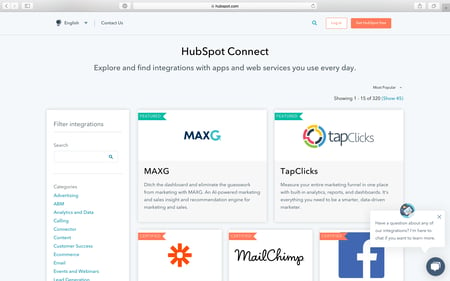Custom HubSpot Integrations
When there’s no integration to connect your system – to HubSpot – you’ll either need a Third Party Connector or a Custom HubSpot Integration.

Webalite has been a Certified HubSpot App Partner since 2022.
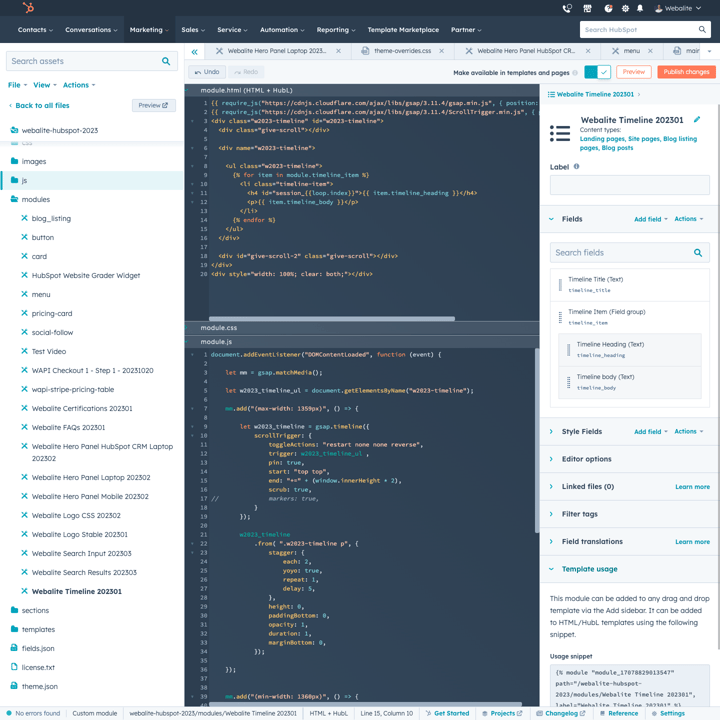

You can connect HubSpot with hundreds of popular apps using HubSpot Integrations. Sometimes, however, the application you need isn’t available.
You can integrate hundreds more apps using 3rd party systems like Zapier and Automate.io. But, these may not have all the features you need to successfully integrate your system with HubSpot.
Why you need integrations
Integrations automatically transfer information between different systems so you can be better informed, make better decisions, and analyse data to improve your business.
Integrations are usually automated which saves you time, eliminates stale data, and reduces the potential for errors that occur with manual data transfer.
No more collating spreadsheets from different systems. It used to take forever to collate your data but now it can be fully automated so you can spend less time collating and more time analysing.
What is an integration?
Basically, information is passed from one system to the other using an integration.
The data is transferred over the internet via APIs (Application Programming Interfaces). These APIs are constantly sending and receiving data over the internet.
Here's a simplified high level diagram of a HubSpot Integration:
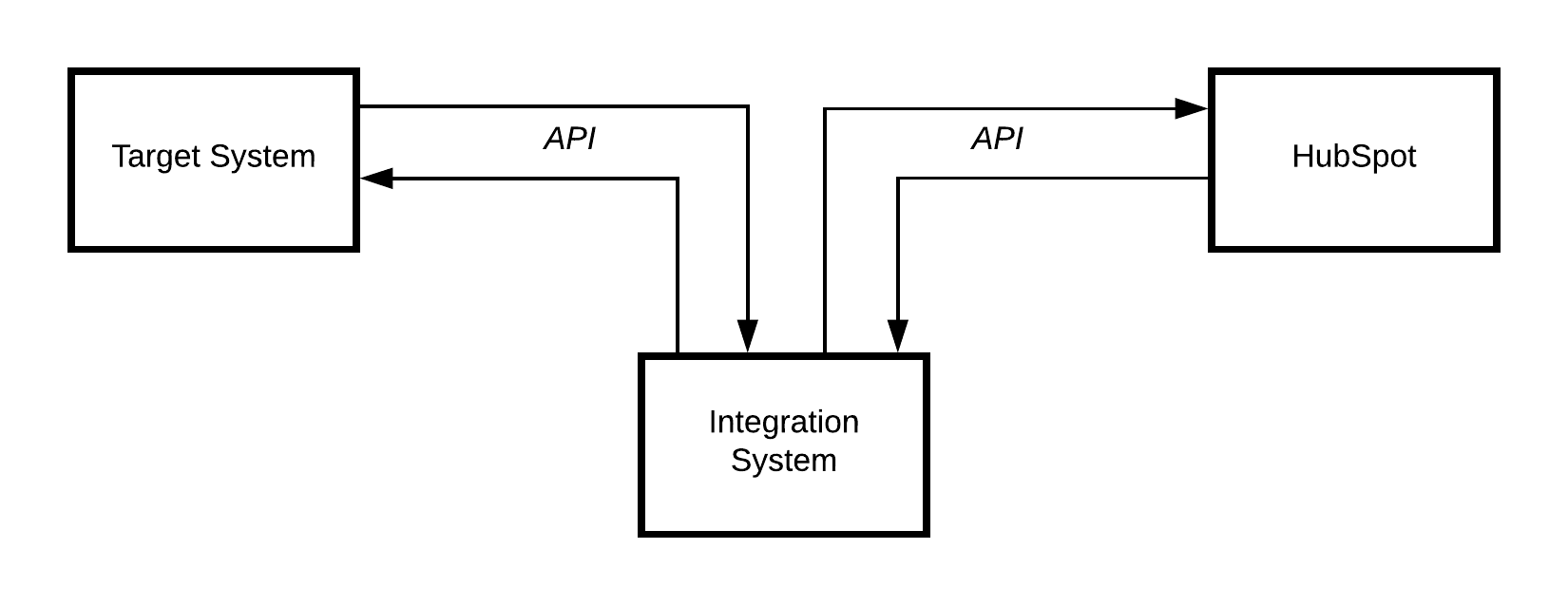
Diagram of HubSpot integration showing API transfers
Can we integrate HubSpot with our system?
This will depend on the system you use. Most online systems have an API to access data from mobile apps and other systems. You’ll want to check their website and look for API Documentation, or, Developer Documentation. If you have a real person to contact you can ask them. Or, if you’d like us to take a look, please contact us.
If the system doesn’t have an API or other way of getting data out it may not be possible to integrate.
HubSpot integrations available through the marketplace
The HubSpot Marketplace is your first place to look for integrations. Here you can find integrations that have been approved and certified by HubSpot.
These are what we call ‘native’. A native integration will be easy to set up and give you immediate access to the functionality you need.
HubSpot App Marketplace
In the HubSpot Marketplace there are hundreds of integrations for applications systems.
Here are some examples of standard integrations:
- The EventBrite integration shares the contact and event attendance information from EventBrite to HubSpot.
- The Xero integration shares contact information with Xero so your accounts system is up to date. The same integration pulls purchase information from Xero so your team can see purchase information in HubSpot.
- The Google Adwords integration tracks customer acquisition from the Google Ad right through the customer journey.
Roll your own HubSpot integration
If you can’t find a native integration in the HubSpot Marketplace you can look into using an intermediary service.
Here's a few of the well known integration services:
You can use intermediary services to transfer data between HubSpot and other systems. The intermediary services give you a number of options to push and pull data between systems based on triggers. A trigger could be as simple as adding a new ‘contact’ in HubSpot.
Here are some typical custom HubSpot integrations:
-
Pushing data into HubSpot after a transaction in an external system (which is not integrated with HubSpot).
-
Pulling data from an external system to display additional information in the HubSpot CRM.
-
Publishing HubSpot information to an external system for complex reporting and analysis.
-
Performing complex maths, or date maths, on HubSpot Properties that reflect your business process.
Unfortunately, not all intermediary services can do exactly what you need. You may find that you can not synchronise complex relationships, nor handle certain data types. So, you'll want to try a few different providers and try them out. If you can't get an intermediary service to transfer your data you may need to consider a custom HubSpot integration.
What is a custom HubSpot integration?
A custom HubSpot integration is custom code which runs in the cloud, separate from HubSpot and the App that you want to sync data with.
The custom code moves data – between HubSpot and your App – at scheduled intervals or in real time using APIs (Application Programming Interfaces).
When to use a custom HubSpot integration
If there’s no native integration, and your system is not supported with an intermediary service, you probably need a custom HubSpot integration.
A custom HubSpot integration can be developed to automate your business process between systems.
HubSpot integrations allow other systems to communicate with HubSpot via an integration server.
The normal integration requires an external Integration System to do the following jobs:
-
Pull and/or push data to/from the API e.g. contact information, company information, and deals
-
validate and/or convert the data for HubSpot e.g. date formats, calculations, etc.
-
retry pushing/pulling if there's a failure e.g. internet connection issue
-
log the transaction so we can see any data issues and fix them
-
reporting (if required) so you can see what's happening.
Here’s a more complex example from Survey Monkey to HubSpot. This custom integration renders a PDF based on the answers from a Survey Monkey Questionnaire.
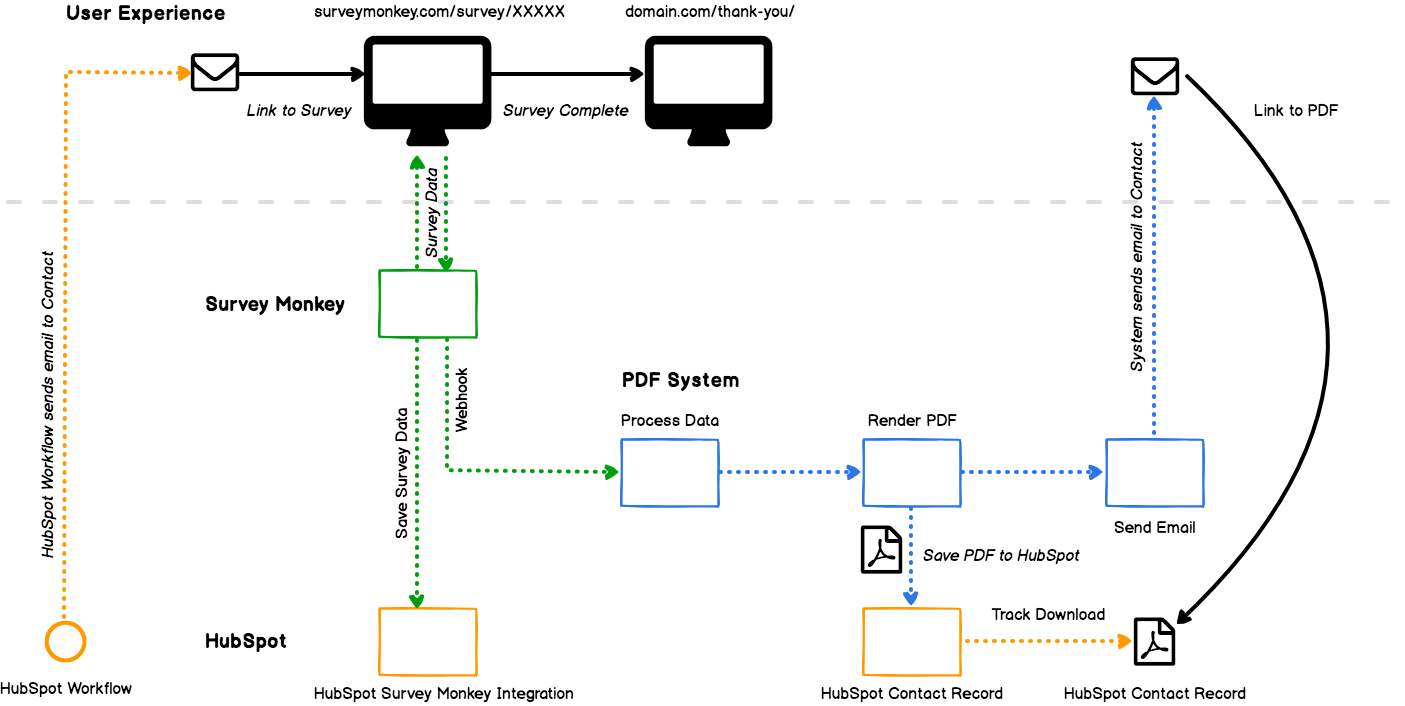
Diagram showing integration rendering PDF from Survey Monkey to HubSpot
Webalite has already created several custom HubSpot integrations to fill gaps in the market.
These include:
-
Portal-iQ - a HubSpot portal auditing tool which provides key recommendations combined with up to date data to help you maximise HubSpot for your marketing, sales and customer support.
-
Primary Contact - a panel in the HubSpot CRM that displays the Primary Contact, for a company, with a link to the Primary Contact.
-
Birthday and Age - automatically* update your contact’s age and next birthday date. *Annual automatic updates require access to Workflows in HubSpot.
Featured Integration
In 2022, the Webalite team developed Portal-iQ through the HubSpot App accelerator programme.
Portal-iQ quickly and seamlessly scans your HubSpot portal to provide you with a comprehensive report full of key recommendations and up-to-date data to help you maximise HubSpot for your marketing, sales, and customer support.
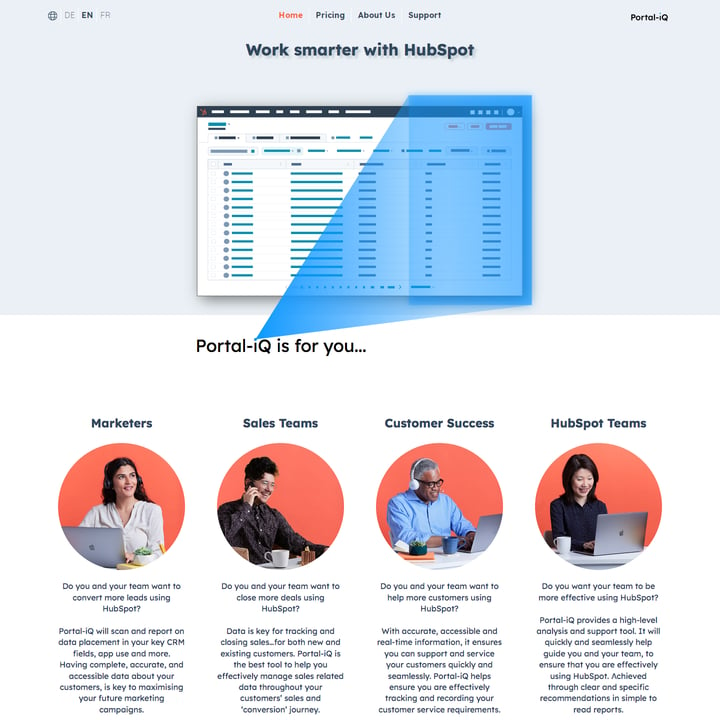

Security and privacy
It’s extremely important that all data transmitted and received by APIs is encrypted. If your data is being transmitted without encryption it will be possible to intercept and read the information.
Privacy is also of paramount importance to us. We do not store any private information on our systems.
You may need to update your terms and conditions when you integrate with 3rd party integration services.
Potential issues with integrations
Our experience over the years has shown us lots of potential issues that can be exposed when building custom integrations. Here are a few of the issues we’ll need to check with you, and specifically, how to handle the exceptions:
-
Data Quality – how good is your data? We’ve worked with databases that have multiple duplicates, stale data, and missing information. When data synchronisation is automated you need a strong set of rules to assess data quality. Simple validation is great, for example, checking dates – but a computer isn’t [yet] smart enough to check data and flag it when it doesn’t look right. E.g. multiple spellings of someone’s name.
-
Data Collisions – when you have multiple data sets you need a clear ruleset to decide which data set is the definitive source. For example, if you synchronise data set A with data set B, which takes priority? If your data is more recent in data set B should it overwrite data set A?
-
Unsubscribe – if your contact has unsubscribed anywhere that usually takes precedence regardless of which data set is more recent. If they’ve unsubscribed and you start emailing them after a data sync you’ll be doing more harm than good.
-
Privacy – are you handling any sensitive information? In HubSpot there’s limited privacy settings to hide confidential information. If you have sensitive information it may be best to store it outside HubSpot and show (based on permissions) the information using a HubSpot CRM integration.
Custom HubSpot integration development process
The last decade of development has helped us refine our process to improve the success of your project, deliver your desired outcomes, and keep on track with time and budget.
Our typical process goes through the following stages:
1. Interrogation – we give you a form to complete – which feels like an interrogation. Our purpose is to learn your business goals, technical requirements, and what systems you need to integrate with.
2. Research – not all Application Programming Interfaces (APIs) are created equally. We research the API and, whenever possible, run tests to see if the data is the same as the documentation (you'd be surprised what we've seen come back from an API).
3. Documentation – we document the process in English (and Geek-speak) so you can review the process and agree it's actually what you want. Once we confirm the requirements we can also work out the budget for the project and any ongoing costs e.g. hosting, support. and maintenance.
4. Development – we develop in a test environment using a test HubSpot portal to send and retrieve data. This ensures everything's working as planned.You and your team will get to test the system to make sure it’s delivering what we agreed on in Stage 3 (and make any adjustments if required).
5. Deployment – we deploy the code to the live server and connect it to your live HubSpot portal. We’ll run more tests to ensure the systems are all communicating as expected.
6. Support & maintenance – we manage any systems that are required in the integration, monitor the logs, and help you if you need any support.
7. Improvements – often we find there are opportunities to improve the system and/or add new features. Often these are outside of the original scope from step 3.
How much does a custom HubSpot integration cost?
Because every business process is different and every API is different it’s impossible to guess a project budget… which is why we’ve created a research and development project so we can accurately estimate the final project.
Stage 1 – 3 are a fixed price project allowing us to create a project plan with pricing and timeframes for the next stages.
What’s the cost of not using an integration?
One of our clients had a manual operation which we replaced with automation. They had approximately 500 customers and every month they completed a series of manual tasks for each customer.
For every manual step we replaced with an automation, most of which took from two to five minutes, we saved an estimated total of 357 hours of admin time, per year.
This freed up the administrators time to work on proactive tasks rather than mundane tasks. Ultimately, the saving was several weeks per year and a happier team member.
Next Steps
A native integration, or an intermediary service will be your easiest and probably cheapest way forward. If you need help setting up an integration please complete the form below.
However, if your business is complex and there aren’t any existing integrations available, a custom integration is the best way forward.
Please fill out this form and we’ll send you our custom HubSpot integration questionnaire to help us understand your needs. Once we’ve reviewed your information we can arrange a time to meet to discuss the next steps.
